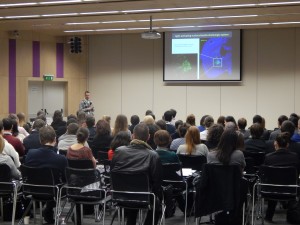The first Hungarian Neuroscience Doctoral Conference was organized in Budapest, with the active participation of our lab: Kati Sviatkó gave a poster presentation :
An open source toolkit for combining neurophysiology and rodent behavior
Katalin Sviatkó, Panna Hegedüs, Tamás Laszlovszky, Nicola Solari, Joshua I Sanders, Balázs Hangya
Neurons in the brain communicate with action potentials timed at millisecond precision. Therefore, mechanistic insight about function often comes from veridical recording of these action potentials. For instance, understanding how neurons represent specific information about external stimuli and internal variables requires registering neuronal action potential firing while animals are engaged in different behaviors. Moreover, to have sufficient statistical power, animals have to repeat these tasks time and again. Thus behavioral neurophysiology has a dual objective: train animals on a behavioral task of interest and record their neuronal activity while they perform the task.
Importantly, the millisecond timing of neuronal firing has strong implication on the scope of behavioral tasks. One can only hope to extract specific information carried by spike timing if behaviorally relevant events of the task, like cue stimuli, go and stop instructions, reward and punishment delivery are under the same precision of temporal control.
Standard experimental setups capable of achieving this are not in routine use. We present an affordable, modular, open source system capable of flexible behavioral task design and execution, submillisecond precision hardware control, combined neural recordings and optogenetic stimulation. Key components of this system are (i) custom designed, modifiable environments for mouse behavior; (ii) open source microcontroller-based behavior control equipment (BPod, designed by Joshua I Sanders); (iii) open source data acquisition system based on Intan technology (open ephys designed by Joshua H Siegle and Jakob Voigts) (iv) open source computer vision based position tracking (Bonsai, desgined by Goncalo Lopes); (v) open source pulse generator (PulsePal, designed by Joshua I Sanders); (vi) light source (laser or LED) and a light coupling system for optogenetic stimulation; (vii) freely available Matlab software package for storing and analyzing combined behavior/electrophysiology/optogenetics experiments (CellBase, developed by Adam Kepecs and Balázs Hangya). How this setup operates will be demonstrated on a simple associative learning task. We believe this system will be a useful tool for a broad community of neurophysiologists.
and Balazs Hangya gave a plenary lecture titled “The role of the basal forebrain in learning”:

